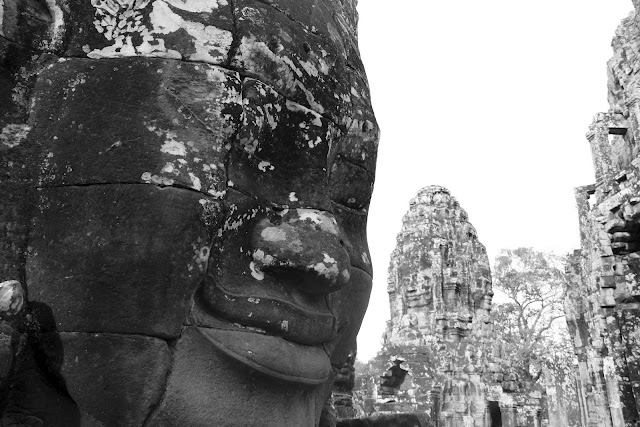Contrairement aux tours organisés
proposant une journée de visite, nous achetons un ticket de trois jours. Cela nous
semblait bien nécessaire pour se rendre compte de l’ampleur du site, classé
depuis 1992 au
patrimoine mondial par l'UNESCO et souvent
considéré comme la 8ème merveille du monde. Impossible de décrire l’ensemble
des 287 édifices recensés dans la région que nous n’avons d’ailleurs pas eu le
temps ni la patience de visiter. Voici juste un petit aperçu des principaux et de
ceux qui ont retenu notre attention.
Tout l’intérêt est d’arriver très
tôt sur le site pour profiter au mieux du calme de la nature en contraste avec
la puissance des temples… et surtout d’éviter les bus de touristes asiatiques
se prenant en photo l’un après l’autre devant chaque pierre !
As most tourists do in order to visit the
ancient temples of Angkor Watt, we lodged at Siem Reao, a small town, located
at about 8km from the temples. The city itself is nothing special, consisting
mainly of tourist facilities such as hotels, restaurants and markets.
Although I thought I might suffer from a
“temple burnout” we got ourselves entrance tickets for three days (same price
as for two days) in order to visit the huge temple complex of a total of 287
buildings built between the ninth and fifteenth century. The site was classified
a World Heritage site by UNESCO in 1992 and is also called the eighth wonder of
the world.
Already in the habit of getting up early in
the morning, we managed to be onsite for sunrise all three days in a row. This
is the best time for visiting the temples as later on the place is crowded with
tour buses and Asian tourists taking turns to take photos of themselves in
front of each stone.
On commence par l’incontournable Angkor
Wat, l’emblème du pays, représenté sur le drapeau cambodgien et dont les 5
tours se dessinent gracieusement au lever du soleil. Les bas-reliefs sculptés
dans la pierre offrent une véritable fresque historique de 800 mètres de long.
Il est considéré comme le plus grand bâtiment religieux au monde.
The temple of Angkor Wat is not only the
largest temple of this temple complex, but it is also the largest religious
building in the world. Its five towers are the emblem of Cambodia and are represented
on the national flag (also one of the country’s most popular beer is named
after it). They represent the spatial universe in miniature.
La cité d’Angkor Thom, a la forme
carré, d'environ trois kilomètres de côté, et entouré d'un rempart
haut de 8 mètres. Ses 5 portes sont ornées d'immenses visages d'un des quatres grand Rois du panthéon hindousite.
“Angkor Thom” is a huge complex built over
10sq km and houses a great variety of temples. The first thing you notice when
entering the enclosed site are its impressive five gates, each decorated with a
huge face.
Au centre de cette cité, on y
découvre le Bayon, la « Montagne magique », un de nos temples préférés
avec ses 37 tours coiffées chacune de 4 visages sourieurs et moqueurs semblant
narguer ses visiteurs. Nous passons une matinée entière à admirer l’expression
de ces figures figées dans la roche.
One of my favorite temples is located on
this site: the “Bayon”, a building consisting of 54 gothic towers, most of
which have four visages towering over the visitors with a cold smile. These
huge faces glare down at you from every angle, so even when you mange to avoid
the crowds of visitors you still feel like you are being watched.
Et enfin, le Tha Phrom qui doit son salut
aux gigantesques arbres dont les racines tentaculaires emprisonnent les
pierres. La puissance et l’importance de la nature prend ici tout son sens.
Another one of my favorite temples is the “Tha
Phrom”, where vast root systems of some spectacular trees embrace the ruins of
the temple. You can feel the power of the jungle here, slowly destroying the
work of humanity.
A la sortie de Siem Reap, nous reprenons la route vers
l’est en direction de Stung Treng. Pas encore rassasiés de vieilles pierres, nous parcourons
les temples du site de Koh Kher, construits avant ceux d’Angkor et à une
centaine de kilomètres de là. L’absence de touristes tôt le matin confère encore
plus de magie au lieu, déminé et ouvert au public depuis peu.
Having survived the three day temple tour
without any mental damages, we made a stopover at the “Koh Ker” temples, the
ancient capital of the Angkor Empire, on our way east to Stung Treng. The
principle monument bizarrely resembles the Mayan pyramids I previously visited
in Mexico. The setting in the forest and the complete absence of other
tourists, gave the visits a magical feel to it.
En chemin, nous logeons dans le
petit orphelinat de Tbang Malea. Le propriétaire tente de maintenir
l’encadrement d’une vingtaine d’enfants, entre autres grâce aux dons de
touristes de passages. Nous jouons tout l’après-midi avec ces enfants très
attachants dont le niveau d’anglais nous impressionne tout particulièrement.
On our way to Stung Treng we stayed a night
at a small orphanage at Tbang Malea. The owner told us that his previous funds
have have been cut and that he no longer receives any official helps, small
donations from tourists support the maintenance. We really enjoyed the warm
welcoming of the children and he children obviously enjoyed the distraction and
kept us company most of the afternoon playing and dancing. Thanks to the
English school also initiated by the owner of the orphanage, even the younger
children had a good command of English.
En bonus exclusif, les premières
images des aventures de Lara Jones et d’Indiana Croft…
Here an exclusive publication of Lara Jones
and Indiana Croft’s newest adventures…








































Aucun commentaire:
Enregistrer un commentaire